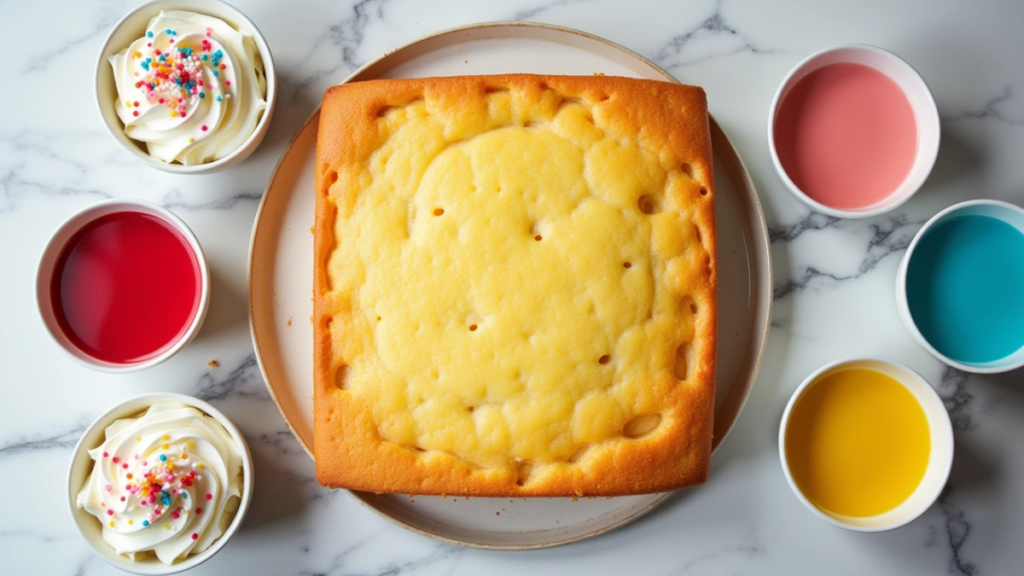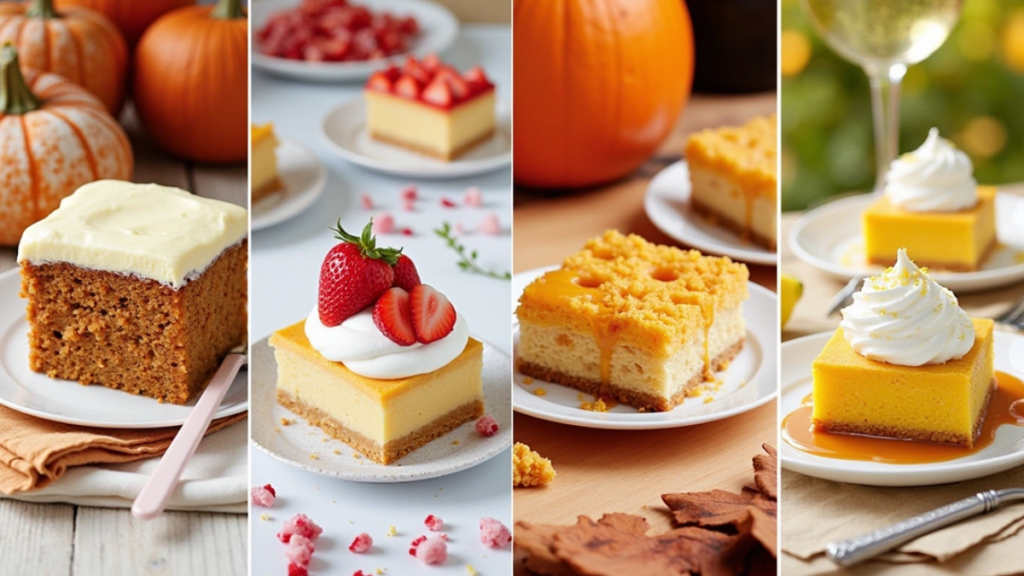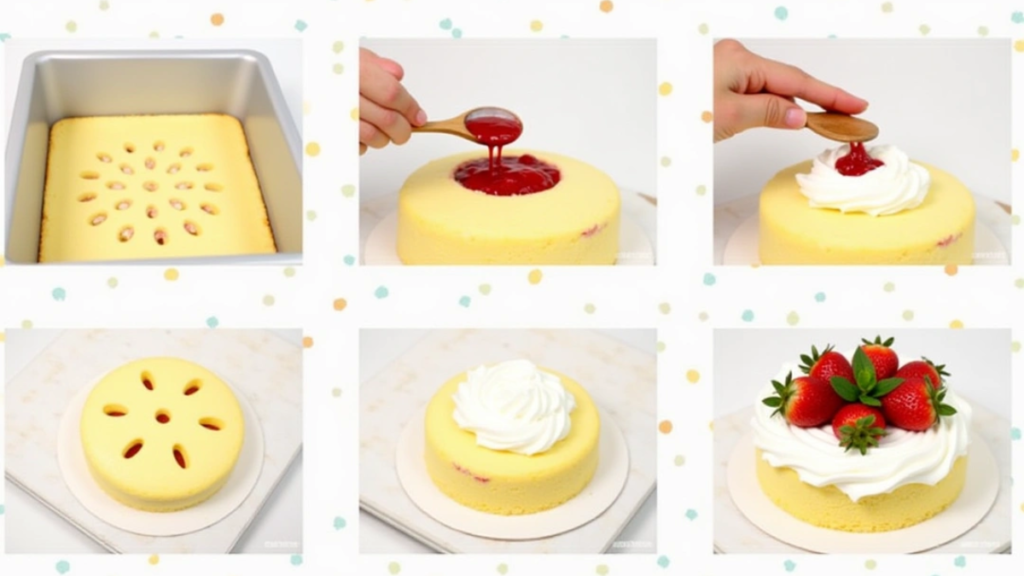Introduction to Poke Cake
Poke cake is a classic dessert that has charmed home bakers and dessert enthusiasts alike for decades. Its origins can be traced back to the 1970s when it became a staple at potlucks and family gatherings, celebrated for its simplicity, creativity, and deliciously moist texture. A poke cake is a simple sheet cake that is “poked” with holes after baking, allowing flavorful fillings—such as pudding, gelatin, or syrup—to seep in and infuse every bite with sweetness.
The concept is as versatile as it is easy to execute, lending itself to countless variations. From fruity and refreshing versions with strawberry or lemon fillings to indulgent chocolate or caramel combinations, poke cakes offer endless possibilities for customization.
In recent years, this nostalgic dessert has experienced a resurgence in modern baking. Social media platforms, food blogs, and recipe videos have revitalized its popularity, showcasing creative twists like boozy poke cakes, vegan adaptations, and even gluten-free options. The poke cake’s revival reflects a growing appreciation for retro recipes reimagined for today’s palates. Its vibrant presentation and the element of surprise in every slice make it a show-stopping treat for both casual and formal occasions.
Whether you’re a seasoned baker or a novice in the kitchen, poke cake is a deliciously rewarding dessert to master.

History and Origin of Poke Cake
Poke cake originated in the early 1970s as a clever marketing strategy by Jell-O, aiming to boost sales of their iconic gelatin products. At its core, the concept was simple yet innovative: a sheet cake was baked, then poked with holes using a fork or skewer, and filled with liquid gelatin. The colorful gelatin seeped into the cake, creating vibrant streaks and pockets of flavor while keeping it moist. Paired with a topping of whipped cream, it quickly became a crowd-pleaser.
The marketing campaign resonated with home bakers looking for quick, fun, and visually appealing desserts. Advertisements emphasized its ease of preparation and versatility, encouraging experimentation with different flavors and color combinations. As a result, poke cake gained immense popularity, becoming a go-to dessert for gatherings, potlucks, and weeknight treats.
Over time, poke cake evolved beyond its gelatin roots. Bakers began experimenting with new fillings, such as pudding, fruit purees, syrups, and even condensed milk. Chocolate and caramel sauces brought indulgent twists, while fresh fruit and cream cheese fillings offered a sophisticated edge. Today, poke cake is a versatile dessert that adapts to any occasion or dietary preference, with versions ranging from gluten-free to vegan.
The resurgence of retro recipes in the modern era has brought poke cake back into the spotlight. Its rich history and endless variations ensure it remains a beloved dessert that continues to delight bakers and dessert lovers alike.

Basic Components of a Poke Cake
Poke cake is a versatile dessert with a straightforward structure that allows for endless creativity. Its simple yet ingenious design revolves around three essential components: the cake base, the filling, and often a topping. Each element contributes to the cake’s signature moist texture and intense bursts of flavor.
1. Cake Base
The foundation of any poke cake is a tender and sponge-like cake base. Traditionally, white or yellow cake is used for its neutral flavor and ability to complement a wide range of fillings. While homemade cakes bring a personal touch, boxed cake mixes are a popular option for their convenience and consistent results. Other variations include chocolate, red velvet, or even spice cakes, depending on the flavor profile desired. The cake is baked in a rectangular pan (commonly 9×13 inches) to ensure easy poking and even filling distribution.
2. Filling
The defining feature of a poke cake is its filling, which is poured into holes poked into the baked cake. This step is where creativity shines, as the choice of filling dramatically influences the flavor and texture.
- Gelatin: A classic option, especially for fruity or colorful cakes, creating a striking visual effect in every slice.
- Pudding: Adds a creamy, indulgent texture and pairs well with chocolate or vanilla bases.
- Fruit Purees: Infuse the cake with natural sweetness and a fresh, vibrant flavor.
- Sweetened Condensed Milk: Used for ultra-moist and rich poke cakes like Tres Leches.
- Flavored Syrups: Perfect for adding unique tastes, such as caramel, coffee, or liqueur-inspired flavors.
After the filling is poured, it is allowed to seep into the cake, ensuring every bite is packed with flavor and moisture. These simple components form the foundation of poke cake’s charm, while allowing endless room for personalization.
Topping: The Finishing Touch of a Poke Cake
No poke cake is complete without a luscious topping that ties the flavors together and adds a layer of texture and visual appeal. The topping not only enhances the overall taste but also contributes to the cake’s moist and creamy profile. Depending on the flavor combination and occasion, there are several popular options to consider:
1. Whipped Cream
Light and airy, whipped cream is the quintessential topping for poke cakes. Its subtle sweetness complements a variety of fillings without overpowering them, making it ideal for fruity or gelatin-filled cakes. Homemade whipped cream with a hint of vanilla or stabilized whipped cream ensures a fresh and smooth finish that holds up well over time.
2. Cream Cheese Frosting
For a richer, tangier flavor, cream cheese frosting is an excellent choice. This topping pairs beautifully with fillings like fruit purees, caramel, or chocolate. Its velvety texture and slight tartness balance the cake’s sweetness, adding depth to every bite. Variations, such as flavored cream cheese frostings with lemon or cinnamon, provide additional layers of complexity.
3. Other Icing Options
Classic buttercream or ganache can elevate poke cakes into decadent desserts fit for special occasions. Buttercream works well with more traditional cake flavors like red velvet or vanilla, while chocolate ganache creates a luxurious finish for pudding or caramel-filled cakes.
4. Additional Garnishes
To enhance the topping, many poke cakes are finished with decorative elements like fresh fruit, sprinkles, chopped nuts, or cookie crumbles. These garnishes not only add visual appeal but also introduce exciting textures and flavors.
Whether light and refreshing or rich and indulgent, the topping is the final flourish that makes poke cake an irresistible treat.
The Poking Process
The poking process is the defining step in making a poke cake, setting it apart from other desserts. This technique involves creating holes in a baked cake to allow flavorful fillings to infuse every bite. It’s a simple yet ingenious method that ensures the cake remains moist, flavorful, and visually appealing.
How to Create the Holes
- Bake the Cake:
Start by baking your chosen cake base in a 9×13-inch pan. Let it cool slightly to make handling easier and prevent tearing during the poking process. - Select a Poking Tool:
The tool you choose depends on the size of the holes and the filling you plan to use.- Wooden Spoon Handle: This is the most common option for creating medium-sized holes.
- Chopsticks or Skewers: Ideal for smaller holes, especially for thinner fillings like syrups.
- Forks: Great for creating multiple tiny holes for light, evenly distributed fillings.
- Poke the Cake:
Using your tool, poke holes into the cake, spacing them about 1–2 inches apart. Ensure the holes go all the way to the bottom of the pan to maximize filling absorption. Even spacing ensures consistent flavor throughout the cake.
Purpose of the Holes
The primary purpose of the holes is to allow the filling to seep into the cake. This not only enhances the cake’s flavor but also keeps it moist and tender. The filling creates pockets of concentrated flavor, ensuring every bite is rich and satisfying.
This simple technique transforms an ordinary cake into a vibrant dessert that delights both the palate and the eye.

Popular Variations of Poke Cake
Poke cake’s versatility and ease make it a favorite for endless adaptations. With countless flavor, seasonal, and cultural variations, this dessert can be tailored to suit any taste or occasion. Here are some popular options that showcase its creative potential.
Flavor Combinations
- Carrot Cake with Cheesecake-Flavored Pudding:
This variation combines the spiced richness of carrot cake with the creamy indulgence of cheesecake-flavored pudding. The pudding seeps into the cake, amplifying its moisture and creating a luxurious texture. Topped with cream cheese frosting, it’s a showstopper for any dessert table. - Strawberry Jell-O with White Cake:
A timeless classic, this combination is light, fruity, and perfect for warm-weather gatherings. The strawberry-flavored Jell-O soaks into the white cake, creating a vibrant, eye-catching treat. Finish it with whipped cream and fresh strawberries for a strawberries-and-cream effect.
Seasonal Variations
- Pumpkin Poke Cake for Autumn:
A celebration of fall flavors, this version features a spiced pumpkin cake base filled with sweetened condensed milk or caramel sauce. Top it with whipped cream and a sprinkle of cinnamon or nutmeg for a cozy, seasonal dessert perfect for Thanksgiving. - Lemon Poke Cake for Spring and Summer:
Bright and refreshing, lemon poke cake is ideal for sunny days. A lemon cake base is infused with lemon pudding or syrup, then topped with whipped cream and lemon zest. This zesty dessert is a crowd-pleaser for spring brunches or summer picnics.
Cultural Variations
- Tres Leches Poke Cake:
Inspired by the traditional Latin American dessert, this poke cake features a sponge cake soaked in a mixture of three milks: evaporated milk, condensed milk, and heavy cream. The result is an ultra-moist, melt-in-your-mouth treat. Typically topped with whipped cream and cinnamon, it’s a celebration of rich, creamy flavors that’s beloved worldwide.

Step-by-Step Guide to Making a Poke Cake
Making a poke cake is a straightforward process that yields a moist, flavorful dessert perfect for any occasion. Here’s a step-by-step guide to creating the perfect poke cake.
1. Preparation of the Cake Base
Start by preparing the cake base according to your chosen recipe or box instructions.
- Choose a flavor that complements your filling and topping, such as white, yellow, or chocolate cake.
- Mix the batter and pour it into a 9×13-inch pan.
- Bake the cake as directed, ensuring it’s fully cooked by checking with a toothpick inserted in the center (it should come out clean).
- Let the cake cool slightly before moving to the next step, as a too-hot cake may crumble during the poking process.
2. Creating the Holes
Once the cake has cooled, use a utensil to poke holes evenly across its surface.
- Tools like the handle of a wooden spoon, chopsticks, or a fork work well.
- Space the holes about 1 inch apart, ensuring they penetrate all the way to the bottom of the cake.
3. Adding the Filling
Pour your chosen filling over the cake, ensuring it seeps into the holes.
- Use a spoon or a pourable container to evenly distribute the filling.
- Common options include gelatin, pudding, fruit purees, sweetened condensed milk, or flavored syrups.
- Gently tilt the pan to ensure the filling spreads evenly across the cake.
4. Applying the Topping
Spread your selected topping evenly over the surface of the cake.
- Popular choices include whipped cream, cream cheese frosting, or buttercream.
- Add garnishes like fruit, sprinkles, or drizzles of syrup to enhance the presentation.
5. Chilling and Serving
Refrigerate the cake for at least 2–4 hours, or overnight, to allow the filling to fully soak into the cake and the flavors to meld.
- Serve chilled for the best texture and flavor.
Tips for a Perfect Poke Cake
Creating a perfect poke cake is simple, but a few key tips can ensure optimal flavor, texture, and presentation. Here are some essential guidelines to elevate your poke cake to the next level:
1. Allow the Cake to Cool Slightly
After baking, let the cake cool for about 15–20 minutes before poking holes. A cake that is too hot may crumble or tear during the poking process, while a completely cooled cake might not absorb the filling as effectively. This slight cooling step ensures a sturdy structure that still welcomes the filling.
2. Use a Pourable Filling
For the filling to permeate the cake thoroughly, its consistency should be pourable but not too runny. Options like prepared gelatin, pudding, fruit purees, or syrups work well. Use a container with a spout or a spoon to control the pouring, ensuring even distribution.
3. Refrigerate for Enhanced Flavor
Once the filling and topping are applied, refrigerate the cake for at least 4 hours or, ideally, overnight. This resting time allows the filling to seep deeply into the cake and the flavors to meld beautifully. Chilling also ensures the topping, especially whipped cream or cream cheese frosting, sets firmly.
By following these tips, your poke cake will turn out irresistibly moist, flavorful, and ready to impress at any gathering.
Frequently Asked Questions (FAQs)
1. Why is it called poke cake?
The name “poke cake” comes from the unique process of poking holes into the cake after it’s baked. These holes, made with a wooden spoon handle, chopsticks, or similar utensils, are the defining feature of this dessert. The holes are then filled with liquid or semi-liquid fillings such as gelatin, pudding, or syrups, which seep into the cake, infusing it with flavor and moisture. The poking technique ensures every bite is packed with delicious surprises, giving the cake its name.
2. Does a poke cake need to be refrigerated?
Yes, poke cakes typically need to be refrigerated. Since they often contain perishable fillings like pudding, gelatin, sweetened condensed milk, or fresh fruit, refrigeration helps keep the ingredients fresh and safe to eat. Additionally, the chilling process allows the filling to fully integrate with the cake, enhancing its flavor and texture. It’s best to refrigerate the cake for at least 4 hours or overnight before serving.
3. What is seed cake made of?
Seed cake is a traditional British dessert that derives its name from the use of caraway seeds. The cake is typically made with a simple batter of flour, sugar, eggs, and butter, with caraway seeds added for their distinctive, slightly sweet and anise-like flavor. Sometimes, additional flavorings like lemon zest or brandy are included. Seed cake is often served with tea and has historical roots dating back to the 17th century.
4. What is imitation crab cake made of?
Imitation crab cake is made with imitation crab, which is a processed seafood product crafted from surimi. Surimi is a paste made from white fish, such as pollock, that is flavored and colored to resemble crab meat. The imitation crab is combined with ingredients like breadcrumbs, mayonnaise, egg, and seasonings to form patties, which are then baked, fried, or sautéed. While it lacks the natural sweetness of real crab, imitation crab offers a budget-friendly alternative for making flavorful crab cakes.
Conclusion
Poke cake is a versatile and crowd-pleasing dessert perfect for any occasion. With its moist texture and endless flavor combinations, it’s no wonder this classic treat has stood the test of time. Whether you’re making a traditional Jell-O version or experimenting with modern twists, poke cake is sure to delight your taste buds.

